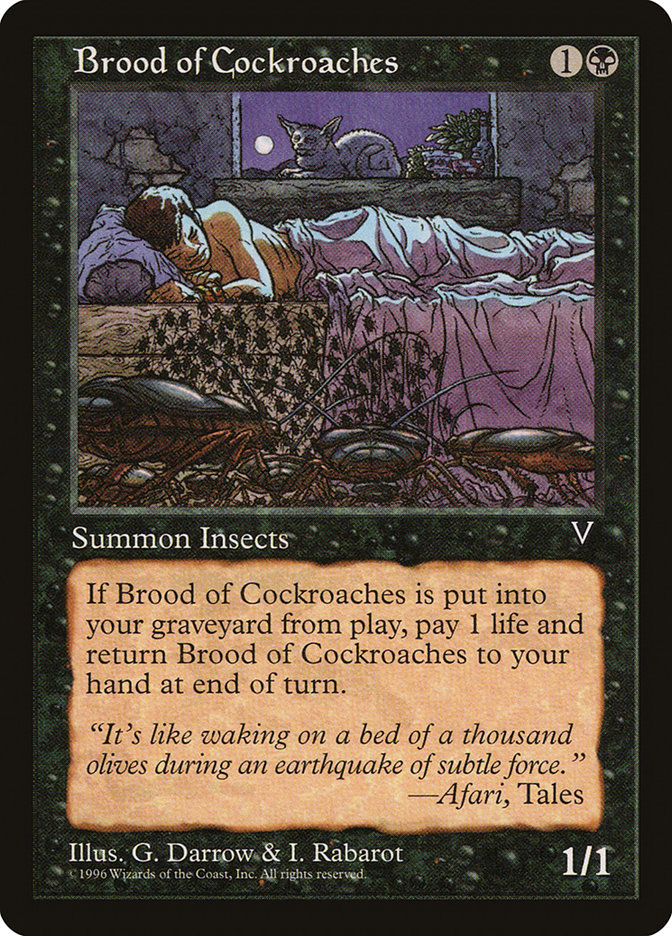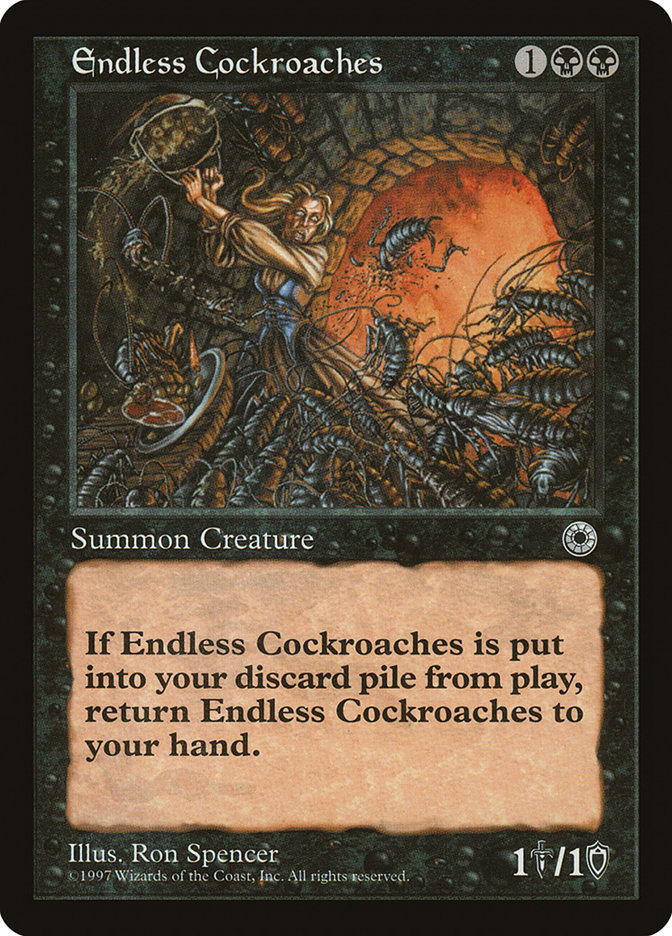Plaga de cucarachas Carta MTG
| El coste de maná | |
| Costo de maná convertido | 2 |
| Rareza | Poco común |
| Tipo | |
| Liberado | 1997-02-03 |
| Coleccione símbolo | |
| Coleccione nombre | Visions |
| Coleccione código | VIS |
| Fuerza | 1 |
| Tenacidad | 1 |
| Número | 53 |
| Frame | 1997 |
| Disposición | Normal |
| Border | Negra |
| Ilustrado por | Geofrey Darrow & I. Rabarot |
Texto de la carta
Si la Prole de Cucarachas se coloca en tu cementerio desde el campo de juego, paga 1 vida y devuelve la Prole de Cucarachas a tu mano al final del turno.
"Es como despertar en una cama de mil olivas durante un terremoto de fuerza sutil." —Afari, *Cuentos*
Cartas Similares
La Prole de Cucarachas aparece como una inclusión única en el departamento de criaturas resilientes de Magic: The Gathering. Comparte sus cualidades perdurables con cartas como Esqueleto Reensamblante, que también puede regresar del cementerio al campo de batalla. La diferencia clave radica en la pérdida adicional de vida incurrida cuando la Prole de Cucarachas regresa a tu mano, a diferencia del Esqueleto que se reanima directamente en el campo de batalla.
De manera comparativa, el Campeón Empapado en Sangre presenta una habilidad similar para volver del cementerio. Requiere un ataque para desencadenar su regreso, lo cual no siempre es una opción, lo que destaca la fiabilidad de la Prole de Cucarachas en casi cualquier situación. Luego está Cucarachas Infinitas, otra criatura con un tema recursivo. Aunque regresa directamente a la mano como nuestra Prole, lo hace solo cuando muere y no garantiza la recurrencia continua proporcionada por la Prole de Cucarachas.
Cuando observamos los matices y pesamos la durabilidad de estas criaturas auto-recurrentes, la Prole de Cucarachas ocupa una posición distinta en Magic: The Gathering. Su regreso garantizado desde el cementerio la convierte en una amenaza persistente y una presencia constante en el juego, incluso si es a costa de un poco de vida.
Aspectos Positivos de la Carta
Ventaja de Cartas: Brood of Cockroaches proporciona una fuente consistente de ventaja de cartas, permitiéndote devolverlo a tu mano desde el cementerio después de que muere. Esto asegura que siempre tengas una criatura para jugar, manteniendo tu presencia en el tablero.
Aceleración de Recursos: Aunque no acelera directamente tus recursos de mana, esta carta regresa de manera constante a tu mano por un mana negro después de ser colocada en el cementerio desde el campo de batalla, concediéndote una criatura para utilizar cada turno.
Velocidad Instantánea: La utilidad de Brood of Cockroaches se extiende a su desencadenante de muerte que puede ser usado a velocidad instantánea. Esto te permite recuperar la criatura al final del turno de tu oponente, manteniendo así tu mana abierto durante su turno para otras respuestas y estrategias.
Aspectos Negativos de la Carta
Requisito de Descarte: Una de las desventajas de Brood of Cockroaches es que su capacidad de recursión viene con un costo. Después de un evento que cause daño que lo mande al cementerio, necesitas descartar una carta para que regrese a tu campo de batalla. Esto puede ponerte en desventaja si tienes en la mano piezas clave o si buscas la ventaja de cartas.
Costo de Mana Específico: Brood of Cockroaches requiere un mana específico para ser lanzado. Con un costo que requiere tanto mana negro como mana genérico, su colocación en un mazo multicolor puede ser un desafío. Es especialmente cierto en mazos que podrían tener dificultades para producir suficiente mana negro de manera consistente o que están construidos alrededor de una curva de mana ajustada.
Costo de Mana Comparativamente Alto: Aunque Brood of Cockroaches ofrece una forma de resistencia, su costo inicial puede parecer alto para una criatura pequeña. Con un precio de un mana negro y un mana genérico, otras cartas en el pool negro pueden tener un mayor impacto en el juego o requerir menos inversión para un efecto recurrente.
Razones para Incluir en tu Colección
Versatilidad: Brood of Cockroaches proporciona una base de criatura resistente que puede regresar repetidamente a tu mano después de morir. Esto lo convierte en una inclusión única para mazos que prosperan en la recuperación de criaturas o que demandan sacrificios para varios efectos.
Potencial de Combo: Su habilidad de regresar a tu mano cuando muere le da potencial en combos que aprovechan los desencadenantes de muerte o requieren sacrificios constantes de criaturas, alimentando sinergias poderosas.
Relevancia en el Meta: En entornos de juego donde son comunes los borrados de tablero o los hechizos de eliminación, Brood of Cockroaches mantiene presencia en el campo, asegurando que los jugadores siempre tengan una criatura lista. Esto puede ser crucial para mantener la presión o defenderse contra estrategias agresivas.
Cómo Vencer
Brood of Cockroaches en MTG representa un desafío único con su capacidad persistente de regresar a la mano de un jugador después de morir. A diferencia de otras criaturas, simula una resistencia y presencia duradera en el campo de batalla, lo que lo hace bastante difícil de eliminar permanentemente. La clave para combatir esta tenaz carta radica en controlar el momento y las condiciones de su muerte.
Utilizar hechizos o habilidades de eliminación de cementerio puede neutralizar efectivamente la recursión innata de la carta. Cartas como Crypta de Tormod, por ejemplo, exilian cartas del cementerio, cortando el problema de raíz. Otra estrategia implica hacer prohibitivo el costo de regresar al Brood, por ejemplo mediante el uso de cartas que aumenten el costo de vida pagado cuando supuestamente debe regresar del cementerio a la mano.
Entendiendo que el daño constante de Brood es una guerra de desgaste, concentrarse en estrategias de ganancia de vida o escudos contra daño repetitivo de criaturas puede disminuir su impacto. Así, los jugadores que anticipan o descubren esta criatura en el lado opuesto deben planificar para un juego largo, integrando elementos de control o amenazas rápidas e incontestables para superar el regreso inevitable de las cucarachas.
Donde comprar
Si estás buscando comprar una carta MTG Plaga de cucarachas de un coleccione específico como Visions, existen varias opciones confiables que debes considerar. Una de las fuentes principales es tu tienda de juegos local, donde a menudo puedes encontrar paquetes de refuerzo, cartas individuales y mazos preconstruidos de colecciones actuales y pasadas. A menudo ofrecen el beneficio adicional de una comunidad donde puedes intercambiar con otros jugadores.
Para un inventario más amplio, particularmente de colecciones más antiguos, mercados en línea como TCGPlayer, Card Kingdom y Card Market ofrecen amplias selecciones y te permiten buscar cartas de colecciones específicos. Las plataformas de comercio electrónico más grandes como eBay y Amazon también tienen listados de varios vendedores, lo que puede ser un buen lugar para buscar productos sellados y hallazgos raros.
Además, el sitio oficial de Magic suele tener un localizador de tiendas y listas de minoristas para encontrar Wizards of the Productos con licencia costera. Recuerde comprobar la autenticidad y el estado de las cartas al comprarlas, especialmente a vendedores individuales en mercados más grandes.
A continuación se muestra una lista de algunos sitios web de tiendas donde puede comprar las Plaga de cucarachas y otras cartas MTG:
 COMPRAR
COMPRAR BurnMana es un socio oficial de TCGPlayer
- eBay
- Card Kingdom
- Card Market
- Star City Games
- CoolStuffInc
- MTG Mint Card
- Hareruya
- Troll and Toad
- ABU Games
- Card Hoarder Magic Online
- MTGO Traders Magic Online
Ver productos MTG
Legalidades
Formatos de Magic the Gathering donde Plaga de cucarachas tiene restricciones
| Formato | Legalidad |
|---|---|
| Commander | Legal |
| Legacy | Legal |
| Paupercommander | Restringido |
| Oathbreaker | Legal |
| Premodern | Legal |
| Vintage | Legal |
| Duel | Legal |
| Predh | Legal |
Reglas e información
La guía de referencia para las reglas de las cartas Plaga de cucarachas de Magic: The Gathering proporciona las reglas oficiales, las erratas emitidas, así como un registro de todas las modificaciones funcionales que se han producido.
| Fecha | Texto |
|---|---|
| 04/10/2004 | La pérdida de vida y el regreso a la mano suceden al comienzo del paso final como un efecto único. No son dos efectos separados. |
| 04/10/2004 | La pérdida de vidas no es opcional. |



